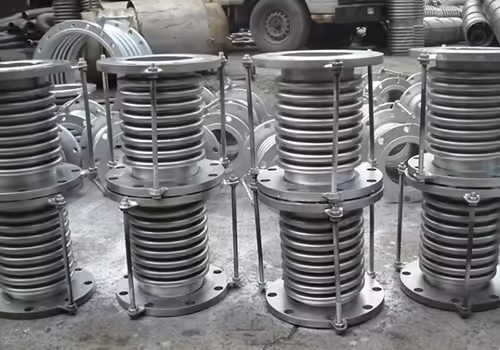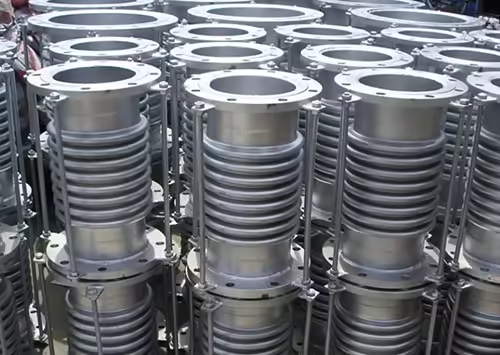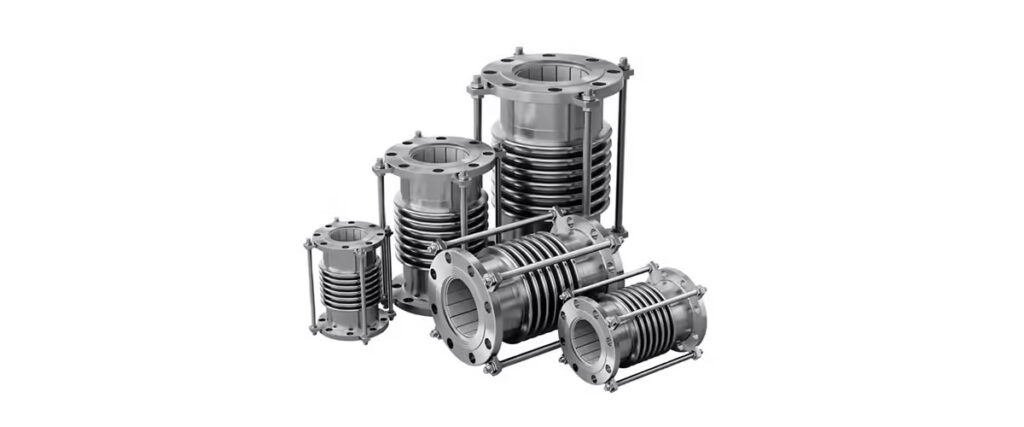Table of Contents
Introduction

When designing and maintaining piping systems, selecting the appropriate pipe expansion joints is critical. These components are essential for controlling stresses caused by thermal expansion, pressure changes, vibrations, and mechanical movements within the piping system. By absorbing these stresses, pipe expansion joints help extend the system’s service life and avoid costly repairs and downtime.
Piping systems are subjected to various stresses, such as temperature changes that cause pipes to expand and contract, as well as external mechanical forces that may cause vibration or misalignment. Selecting the appropriate expansion joint ensures your system operates safely and efficiently over the long term. This guide will explore the key factors to consider when selecting piping expansion joints, helping you make informed decisions to enhance the performance and lifespan of your piping system.
What Are Pipe Expansion Joints?
Pipe expansion joints, also known as expansion bellows, are flexible components designed to accommodate the natural expansion and contraction of piping systems. They are usually made from materials such as rubber, stainless steel, or composite materials and can absorb axial, lateral, and angular movements.
These joints are critical in preventing mechanical failure by minimizing the strain on pipes and supporting structures. When installed correctly, they absorb the thermal expansion and contraction of pipelines, as well as mitigate vibrations that could otherwise cause damage to the system.
Expansion joints are versatile and are used in a variety of industries, including chemical processing, power generation, and HVAC systems. The ability to customize these joints based on pipe size, material, and movement types ensures their applicability to a wide range of industrial applications.
Factors to Consider When Choosing Pipe Expansion Joints
The selection of pipe expansion joints depends on several factors that will influence the joint’s performance, durability, and suitability for the system. Here are the primary factors to consider:
1. Material Selection
The material of the expansion joint plays a crucial role in determining its effectiveness, durability, and suitability for specific applications. Different materials offer various benefits depending on the pressure, temperature, and environmental conditions of the pipeline.
- Rubber Expansion Joints: Ideal for low-pressure applications, rubber joints provide excellent vibration damping and flexibility. They are cost-effective and widely used in systems where mild pressures and temperatures are present.
- Stainless Steel Expansion Joints: These are the go-to solution for high-pressure and high-temperature applications. Stainless steel joints are resistant to corrosion, oxidation, and mechanical wear. They are often used in industries such as chemical processing, power generation, and oil and gas.
- Composite Materials: Some systems require a combination of the benefits of rubber and stainless steel. These composite joints are used in specialized applications where both flexibility and strength are necessary, particularly in systems exposed to aggressive environments.
2. Pressure and Temperature Requirements
The pressure and temperature conditions of your system will directly impact the performance and longevity of the pipe expansion joint. Be sure to choose an expansion joint that can handle the maximum operating pressure and temperature.
- High-Pressure Systems: Systems that operate under high pressure need robust expansion joints, often made from stainless steel or other high-strength materials. These joints help maintain the integrity of the pipeline under extreme conditions.
- Temperature Extremes: When working with systems that are exposed to high or low temperatures, selecting materials that can withstand temperature variations is essential. Metal bellows expansion joints are often the preferred choice for systems operating at elevated temperatures.
3. Movement Type
Pipe expansion joints are designed to absorb different types of movement within a pipeline. The movement types can include axial, lateral, and angular displacement, each of which requires a specific design of expansion joint.
- Axial Movement: The most common type of movement is axial expansion or contraction, which occurs when the pipe lengthens or shortens due to temperature changes. Expansion joints designed for axial movement can absorb this linear change in length, protecting the pipeline.
- Lateral Movement: Sometimes, pipelines shift horizontally or laterally. Expansion joints designed for lateral movement accommodate these changes and prevent strain on the pipeline.
- Angular Movement: In some systems, pipes may bend or rotate at an angle. Expansion joints designed for angular movement help manage these shifts, ensuring that the pipe remains aligned and stable.
4. Environmental Considerations
Environmental conditions can have a significant impact on the performance and lifespan of pipe expansion joints. Factors such as exposure to corrosive substances, UV radiation, or harsh weather conditions can lead to the degradation of the material over time.
For example, systems exposed to corrosive chemicals or abrasive environments require expansion joints made of materials that resist wear and tear, such as stainless steel or fluoropolymer-lined joints.
5. System Design
The overall design of the piping system, including layout, spacing, and structural support, influences the selection of pipe expansion joints. Expansion joints must be strategically placed to ensure optimal performance and absorb movement effectively without causing stress to the surrounding components.
In systems where vibration or thermal movement is prominent, multiple expansion joints may be required to distribute stress evenly across the pipeline.
How to Choose the Right Size for Pipe Expansion Joints

Choosing the correct size for your pipe expansion joints is essential to ensuring their effectiveness. The size should be compatible with the pipe diameter and the expected movement of the system.
| Metal corrugated compensator | |
| Maximum pressure | 2MPA |
| Maximum temperature | ﹣50-600℃ |
| Applicable media | Applicable to various pipeline facilities |
| Scope of application | DN50-DN6500 |
Applications of Pipe Expansion Joints
Pipe expansion joints are used in a wide range of industries and applications, including:
1. Chemical and Petrochemical Industry
In chemical plants, expansion joints are used to accommodate the stresses caused by temperature variations and chemical reactions. Stainless steel or special alloy joints are preferred in these applications due to their resistance to corrosion and high temperatures.
2. Power Plants
Power plants utilize pipe expansion joints in steam and gas lines, where high temperatures and pressures are common. Metal expansion joints are designed to absorb the expansion caused by thermal fluctuations, preventing damage to pipes and reducing the risk of failure.
3. HVAC Systems
In large-scale HVAC systems, expansion joints are used to absorb vibration and minimize noise. They also help in adjusting to temperature and pressure changes, contributing to the overall efficiency and longevity of the system.
4. Water and Wastewater Treatment
Expansion joints are essential in water and wastewater treatment facilities to manage fluctuating pressures in the pipeline system. They help reduce strain on pipes, allowing for consistent flow and preventing pipeline failure.
The Importance of Flexibility and Durability in Pipe Expansion Joints

Metal corrugated compensator
Absorbs the change of pipeline axial dimension, reduces noise and vibration, and has a longer service life. Stainless steel material is corrosion-resistant, high temperature and high pressure resistant
The flexibility and durability of pipe expansion joints are key factors that determine their performance. Flexible joints can absorb a wide range of movements without causing damage to the surrounding piping system. This flexibility is especially important in systems where temperature changes and vibrations are frequent.
Durability is equally important. High-quality materials such as stainless steel and composite alloys ensure that the expansion joints can withstand harsh operating conditions for an extended period of time, reducing maintenance costs and improving the reliability of the system.
Conclusion
Selecting the right pipe expansion joints for your system is critical, as it will impact the long-term performance, safety, and cost-effectiveness of your piping system. By considering factors such as material, movement type, and environmental conditions, you can make an informed decision to ensure your system runs smoothly for years to come.
At Modern Sealing, we offer a variety of customizable pipe expansion joints designed to meet the specific needs of your piping system. Contact us today to learn more about our solutions and how we can help you optimize your piping performance.
FAQ
What materials are commonly used for pipe expansion joints?
Pipe expansion joints are made from materials like rubber, stainless steel, and composite alloys, depending on the system’s pressure, temperature, and environmental conditions.
Can pipe expansion joints be installed in existing pipelines?
Yes, expansion joints can be retrofitted into existing systems to accommodate thermal expansion, vibration, and other stresses.
How do I choose the right size for an expansion joint?
The size should match the pipe diameter, and the joint must be able to handle the expected movement, pressure, and temperature conditions.
How do I maintain pipe expansion joints?
Regular inspection for signs of wear, corrosion, or deformation is essential. Replace the joints as needed to prevent damage to the pipeline.
Are pipe expansion joints customizable?
Yes, expansion joints can be customized based on specific requirements such as size, material, and movement type.


